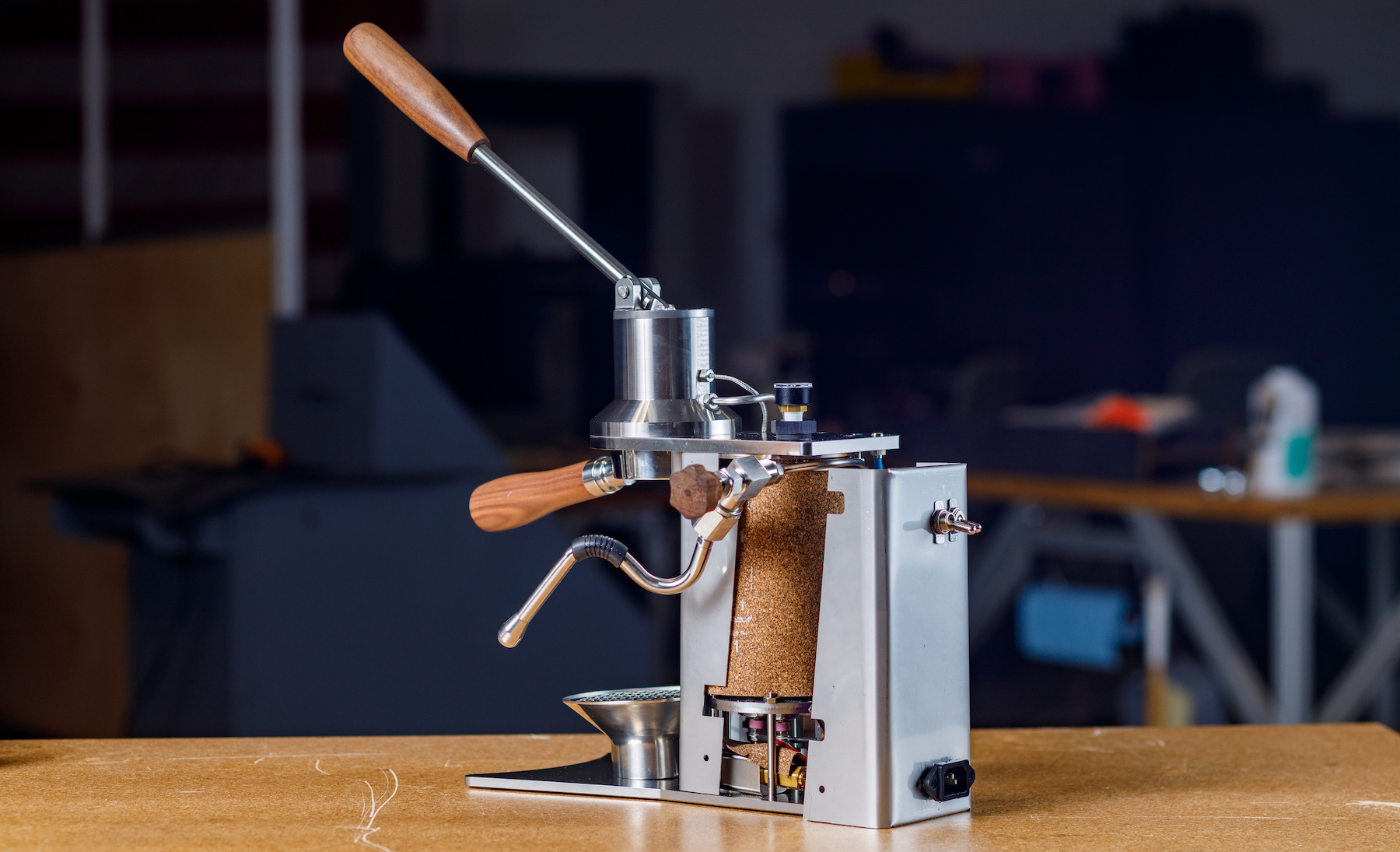Products You May Like
It’s no secret that lever espresso machines are a particular passion at CoffeeGeek. We write about them all the time (check out our look at the Flair Espresso machine, the Cafelat Robot, and going way back, our look at the Elektra Micro Casa a Leva in 2002!). We also follow the lever market closely and know the ins and outs of it, and to be honest, it’s not been great for home lever enthusiasts, at least in the powered machine market. It seems we’ve been stuck with design and technology designed in the 1950s and 1960s for most machines available today (like the Elektras and Pavonis),
There is innovative and “pretty” stuff out there. If you have 8,000 Euros ($9,000USD!), you can pre-order a Manument Lever machine which was introduced last year, and still hasn’t seen production. If you have 2,500 Euros laying around, you can buy the very low-technology Streitman CT2 espresso machine which definitely looks super cool but I’m not sure if paying well over $3,000USD (once shipping and such is factored in) for some nice industrial design with a basic 350ml boiler is a sound investment. There’s also the Profitec 800, which is a very modernized take on a lever machine, if you have $4,300 to spend.
The problem with all the above is it’s either a) too expensive, b) not enough modern features, or c) both. You could go the manual lever espresso route (we like the Flair lineup, but especially love the Cafelat Robot), but they are unpowered manual machines, and there’s no option to steam milk with either of them.
Now something new has come along: the Argos Lever Espresso machine from Odyssey Espresso. Not only is it pretty to look at (especially if you like a steampunk kind of look to your tools and equipment), but it is thoroughly modern with a PID controlled boiler and bluetooth connectivity with an app. And it doesn’t stop there: the machine is also highly customizable, even to the point where it can be super customized depending on if you’re right or left handed. Let’s talk a bit more about this new machine.
The Argos
Ross Ainsworth is the person behind Odyssey Espresso and the Argos. Fascinating guy with a real love for lever espresso. We did a feature interview with him on this product and his plans as a companion piece to the blog post, please go give it a read.
Ainsworth designed the Argos from the ground up to be modular and even expandable (to the point where a plumbed in option might be viable down the road). It’s also designed to be economical to produce and sell: the goal is to keep the machine’s retail price below $1,000, which for a boutique, handbuilt (in the USA) machine with PID controls and lots of customizations, seems like a huge bargain.
Modular
What makes this a modular lever espresso machine? It’s the first consumer machine I’m aware of that can be easily switched between a spring loaded lever system using either an 8BAR or 6BAR spring, to a direct lever, you are the pump kind of machine. There’s often arguments back and forth in the lever espresso community about which is better – spring pistons or direct levers. With this machine, not only can you switch back and forth between the two modes, but you can even swap out the 8BAR spring for a 6BAR spring. This gives some real options in hand crafting espresso.
“The 8BAR spring provides a traditional strong espresso taste and mouthfeel allowing for a finer grind but can be more difficult to get right.” Ainsworth says. “The 6BAR spring is great for low pressure “turbo” shots which have been reported to have higher extraction yield. One can expect a sweeter and more balanced shot with the lower pressure spring while also requiring less force to pull the lever handle down and being less prone to channeling.”
On the direct lever mode, Ainsworth says: “Pulling a direct lever definitely has a learning curve at first; it can be difficult to get a nice and consistent extraction. For those that like to experiment, it’s nice to customize your pressure profile based on the type of bean or roast that you’re using. It’s a fun process of varying pressure in order to create that perfect shot.”
Here’s a look at how the machine can be changed from direct lever to spring piston lever modes.
The modularity doesn’t end there. Ainsworth designed the Argos so that the steam wand assembly and controls can be custom installed at the factory for left or right handed operation. I’m a leftie, and I can’t tell you enough how much I appreciate something like that.
The wood accent side panels are held in place via magnets, and can be easily swapped out with another wood type, giving the machine a fresh look. You should also be able to order different wood handles and knobs from Odyssey Espresso to further change the look of your Argos should you want to, down the road.
Technology
Ainsworth designed in a lot of technology for this machine, including a datalogging system, PID controls for the boiler, and even bluetooth technology and a companion app.
The PID system is fairly standard, but the Argos goes with an analogue dial for setting the temperature, in keeping with the steampunk look for the machine. It might be possible to also set the temperature via bluetooth and the companion app down the road, but that is just in the planning stage. The boiler is relatively small (about 6 shots worth) so the transition time between brew temperatures (PID controlled by the user) and steam temperatures (preset) are not long.
The logic board inside is complex, has Bluetooth connectivity and can communicate a lot of information with a companion app that Odyssey Espresso is developing. And it’s not just information like operation time, water temperatures and fluid levels. There’s even more planned.
“All units have Bluetooth capability so we decided to develop an app to display general machine data like temperature and fluid levels and more.” Ainsworth says. “We’ll also be offering an additional wireless pressure transducer as an option, that will plot real time pressure as users are pulling down on the lever in the direct configuration. This is a great fit for people that may want to save a pressure profile from a pull that they really enjoyed and use that as an overlay to recreate the shot in the future. This also allows users to takes notes as they try out different roast styles, temperatures, bean origins, et cetera, to keep track of what they like and don’t like.”
The Argos in Use
Not many people outside of Odyssey Espresso have used the Argos yet, so we’re relying on what the company says about the machine and its capabilities.
That said, they are looking into all aspects of the machine and even doing some last minute fine tuning to improve it before the first units ship.
One example: the springs used are being fine tuned. The company has tested how the springs react and what their decline in pressure is over the shot pull, with the current units going from 8BAR to 3.5BAR by the end of the shot (this is a good thing in lever espresso and it’s why people think spring lever espresso shots are the best the world – that declining pressure and temperature of water).
Speaking of declining temperatures, Odyssey Espresso has also studied the thermal loss in the grouphead during shot pulls; they saw declines from 93C to 86C through the shot process, which again is very much in line with some of the most desirable ranges on other lever grouphead designs. It also remains consistent over shot pull after repeated shot pull.
That back to back shot ability is another benefit of the Argos’ design. Traditional lever machines like the La Pavoni or Elektra keep water in the boiler at steam-producing levels, and have designed their groupheads to leech off that extra hot water temperatures (usually up to 125C in the boiler under pressure). The problem is, that only works for the first shot pull. If you try pulling a second shot right away, the grouphead is now super-heated too, and your espresso pull will be absolutely burnt.
With the Argos and its two stage boiler, you can confidently pull repeated shots of espresso, one after the other, and the grouphead will not overheat. When you want to steam milk, flip a switch on the back, wait one minute, and the machine is ready to steam milk.
Conclusion
In this era of the $2,000, $4,000, and even $9,000 powered lever espresso machine, seeing the Argos going for under $1K is refreshing.
Even more refreshing is how cutting edge it is in many ways, and how unique the machine is. Left or right handed operation? Check. Spring lever or Straight Piston? Your choice. 8BAR spring, or 6BAR? Again, your choice. PID controlled? Taken care of. Dual mode boiler for brewing and steaming? Yup. Beautiful minimalist design? They got you covered on that.
All this said, at this point the Argos is still essentially vaporware. Odyssey Espresso and Ainsworth plan on shipping the first pre-orders in April of this year (2022), and possibly getting test units out to a few reviewers, our website hopefully included, and that’s when the real talk about this machine and what it offers will start to be heard. If you’d like to be an early adopter, the machine starts at $850USD on the company’s pre-order page.
For us at CoffeeGeek, we absolutely love and adore levers. To see this new product coming to market, it bodes well for thousands of people to discover the joys of and rewards of lever espresso brewing. We really hope it’s a major success.






